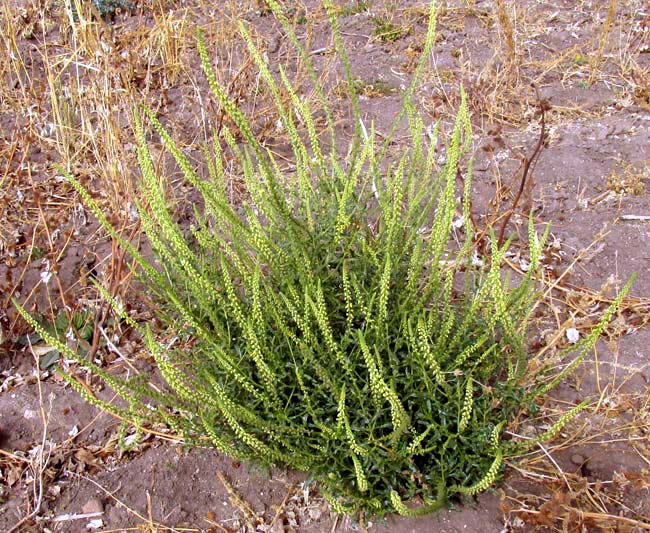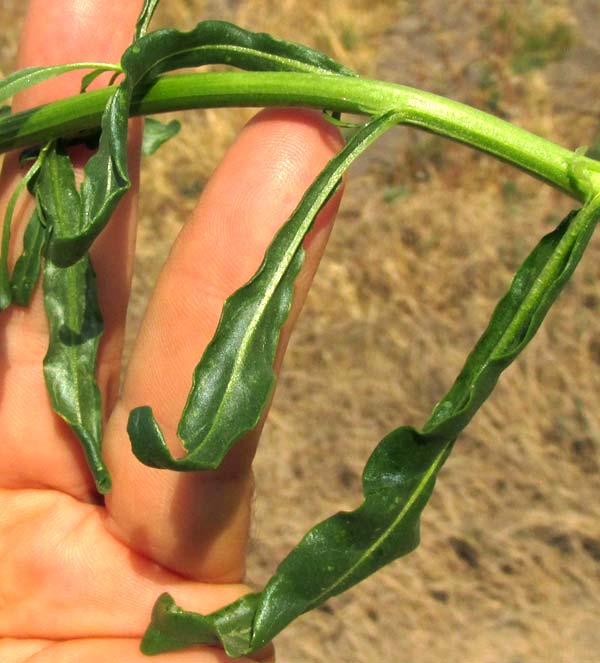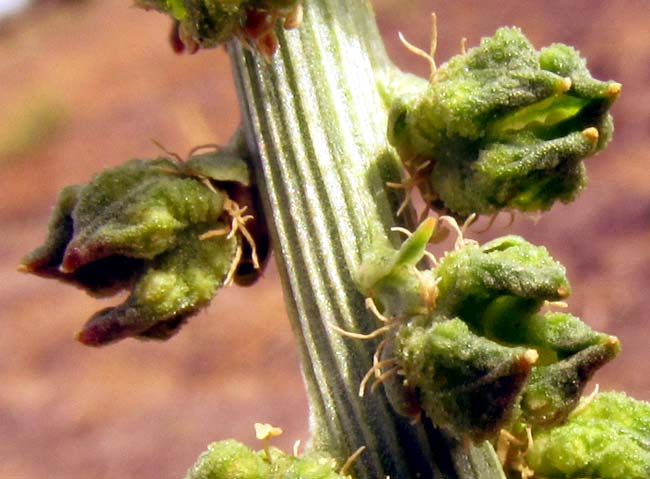Excerpts from Jim Conrad's
Naturalist Newsletter
entry of February 17, 2022, issued from near Tequisquiapan, elevation about 1,900m (6200 ft), N20.565°, W99.890°, Querétaro state, MÉXICO

DYER'S ROCKET
Here in the heart of the dry season, the above biennial weed, about a meter tall (1 yard) is conspicuous in disturbed areas, especially in dusty, dried-out, fallow fields awaiting rain, where sometimes it forms extensive, yellowish splotches in the otherwise gray-brown landscape. Despite it's abundance, when I first looked at it closely, its combination of features of flower and fruit mystified me; it was unlike anything I'd ever seen. The plants' only "normal" parts were their hairless, wilted leaves and stems, shown below:

The tall, slender, raceme-type flowering heads bore unopened flower buds at their tips, with flowers in various stages of development opening below, and maturing fruits at the bottom. Below, you can see what's so unusual about the blossom:

The upper white petals are much larger than the lower ones. It looks like numerous petals are present, but with a hand lens you can see that there are only four, but some of the petals are deeply incised, the slender lobes joining at the base. The top petal has several lobes. The calyx comprises 4 sepals of two different sizes and shapes. And the corolla is packed with about 30 stamens, which mature at different times, the older anthers falling off, leaving slender, naked filaments. Below, an older flower shows a mixture of ripening anthers and filaments without anthers, with the petals having fallen away:

When all the petals and stamens fall away and the fruit, with a few antherless filaments holding on below, splits along three sutures, revealing nearly spherical, green, pea-like seeds stacked atop one another, as shown with the splitting carpel in the image's top, right corner, below:

In the above image, notice that the bottom margins of the triangular, splitting carpels are slightly green-warty. Though I can find no mention of this in the literature, in the picture below it looks as if these "warts," presumably glands of some sort, eventually enlarge, pushing the split carpels farther apart, making it easier for seeds to fall out.

If you know your plant families, unless you're Eurasian or just know this plant as an American weed, it'll be clear that this plant is unlike anything in the American native flora. It's the Dyer's Rocket, RESEDA LUTEOLA, of the family Resedaceae, which has no commonly accepted English name other than maybe the Reseda Family, after this genus. It's a fairly small family with only about 85 species in 6 genera occurring in temperate and subtropical areas. In Mexico it's invasive in the cool central uplands but absent from the hot south and coastal regions.
Both our plant's English and binomial names tell us what Old-World societies found useful about the species: The "Dyer's" in the name speaks of its use as a dye, while the species name, luteola, means "yellowish." At least since Roman times it's been used to produce a yellow dye, as a consequence of its containing a high content of the yellow flavonoid luteolin. When combined with yellow-flowered European plants of the Cabbage Family called Woads, Isatis tinctoria, you get "Saxon Green," a greenish-gray hue used when you're wanting an off-white paint for a wall.
Phylogenetically speaking, the most familiar plant family somewhat closely related to the Reseda Family is the Cabbage Family, with which it shares the features of normally bearing 4 sepals, 4 petals, stamens of different lengths, and pods splitting to release more or less spherical seeds. However, no member of the Cabbage Family produces so many stamens in its flowers, and pods of that family split along two lines, not three.
Despite being close to the Cabbage Family, Dyer's Rocket isn't considered edible for humans, and in fact in considered mildly narcotic. However, in our fields where there's no greenness at all other than the stems and leaves of Dyer's Rocket and Prickly Poppy, leafcutter ants pass right by the Prickly Poppy to harvest Dyer's Rocket leaves and young flowers, to the point of leaving a little forest of leafless stems. I've also seen cattle eat the plant's leaves, though not enthusiastically.